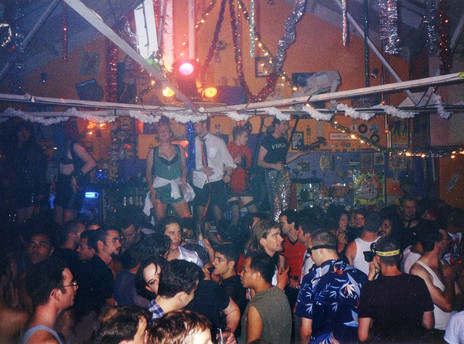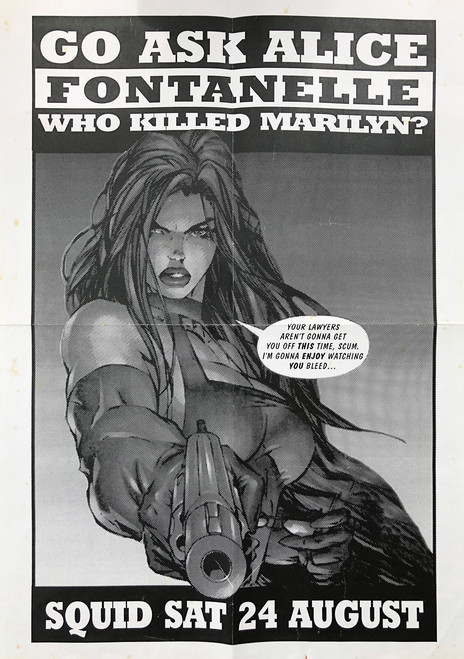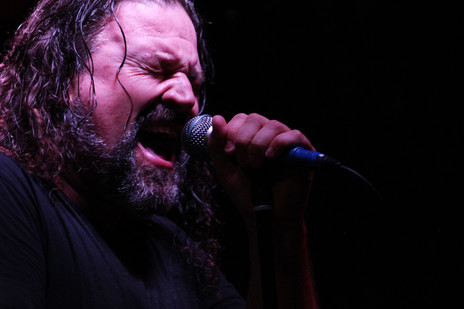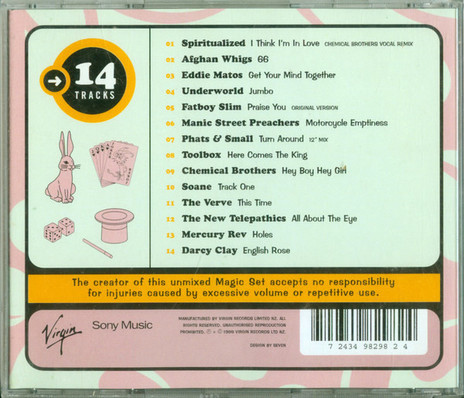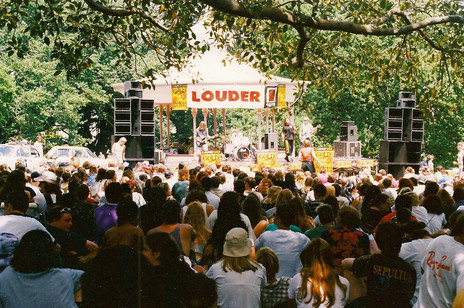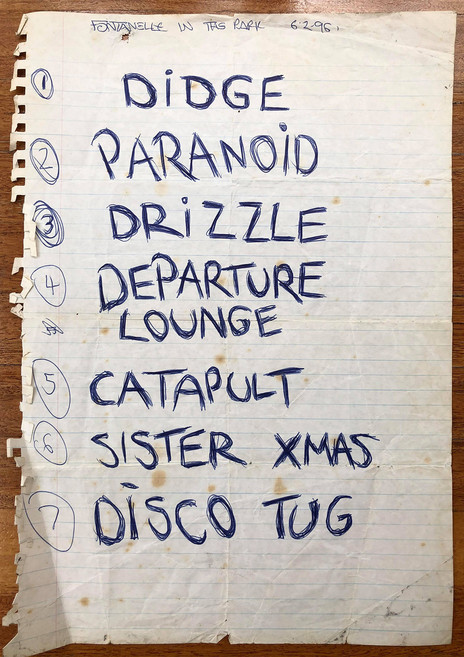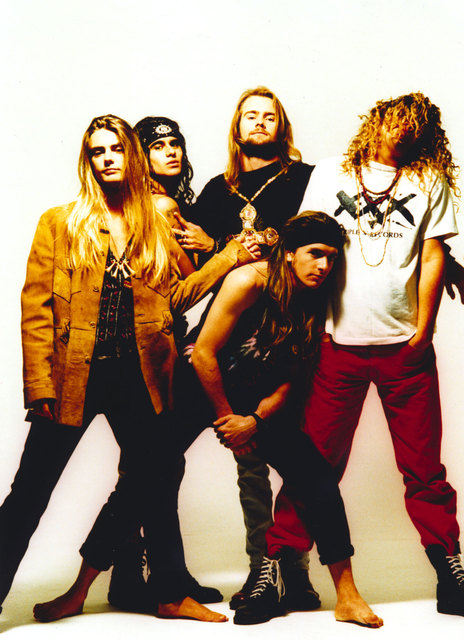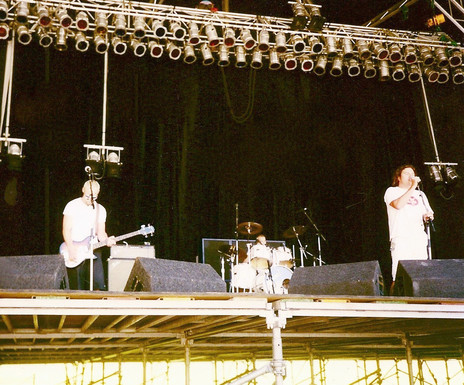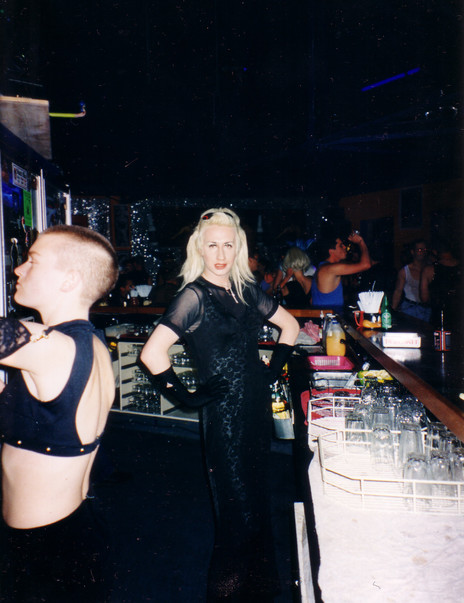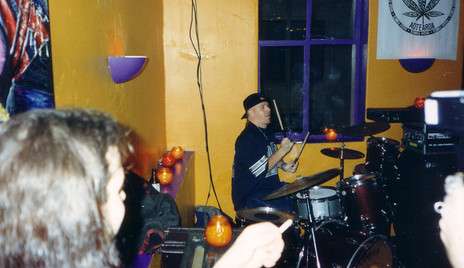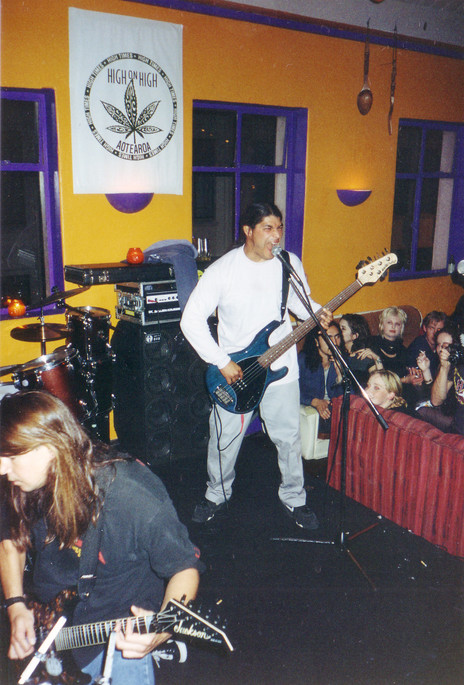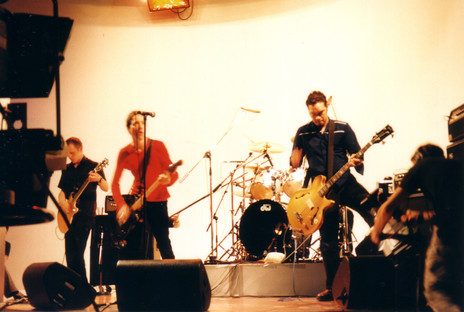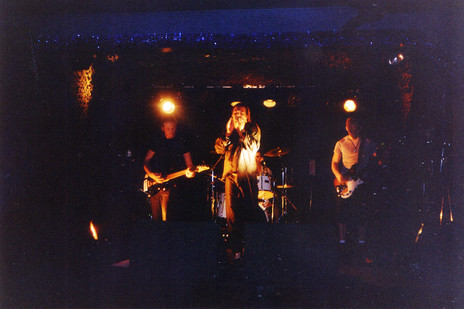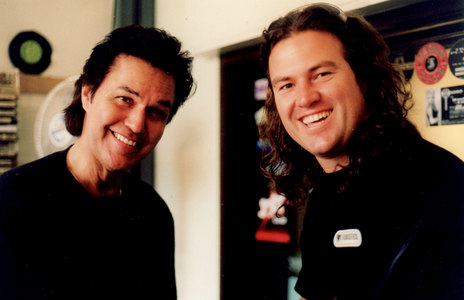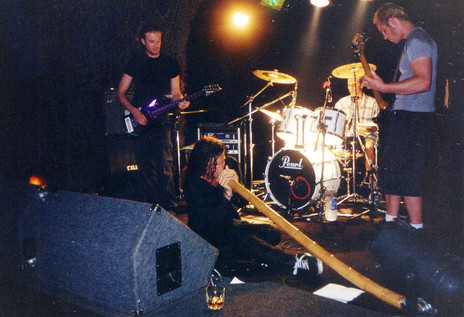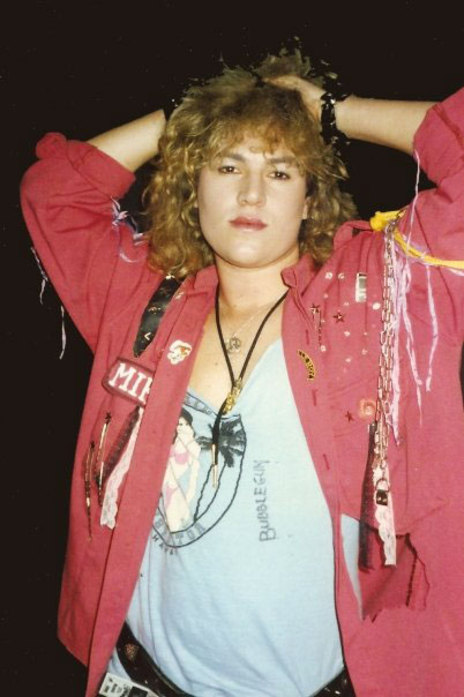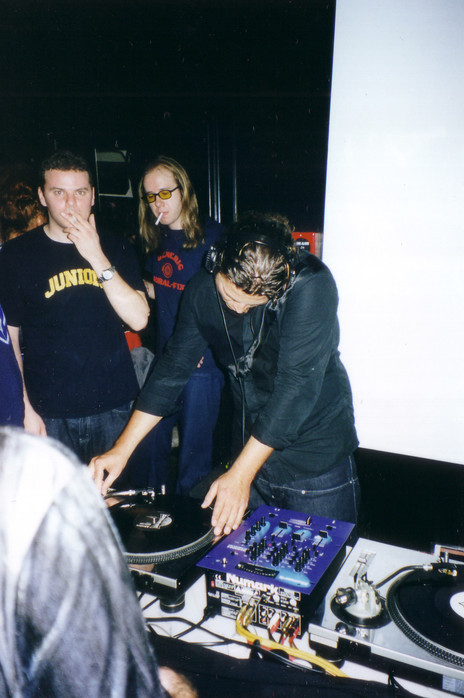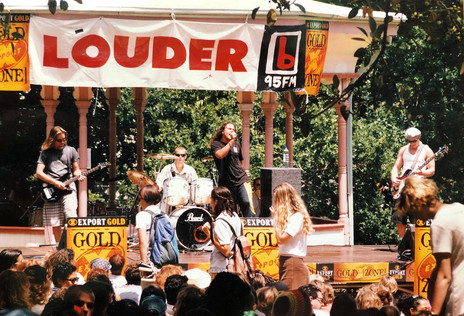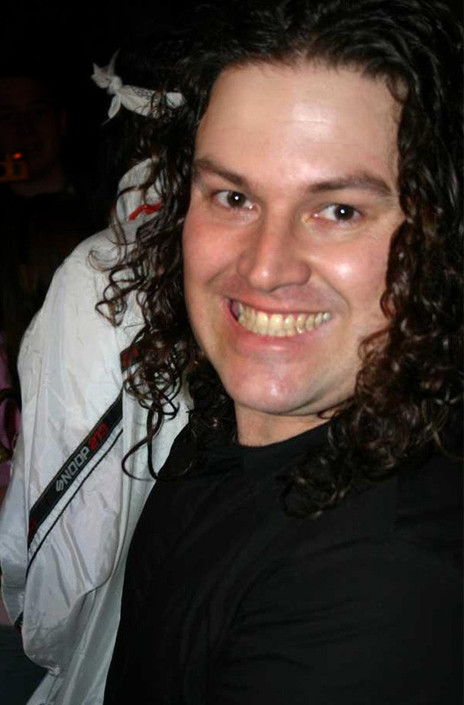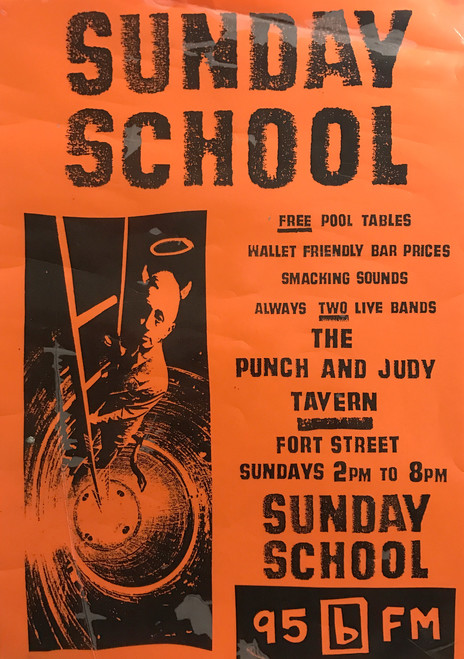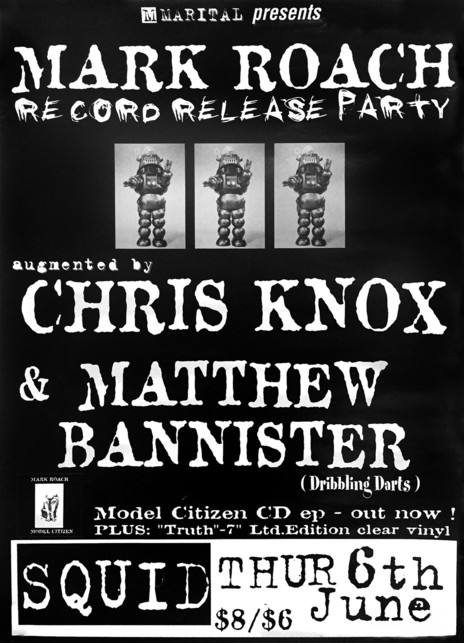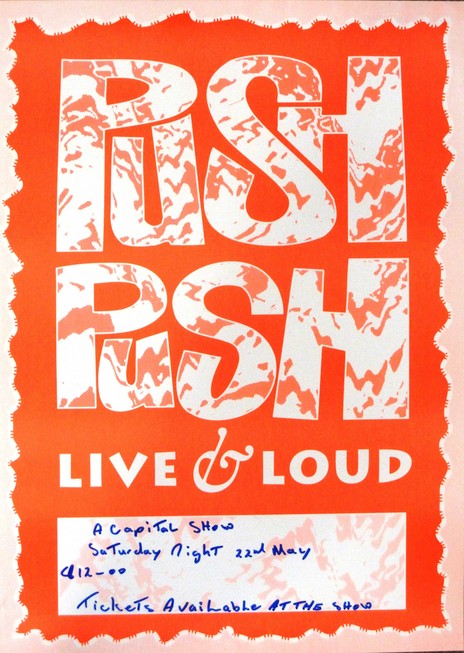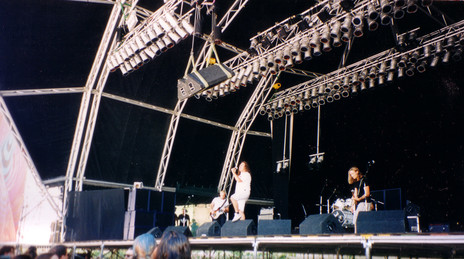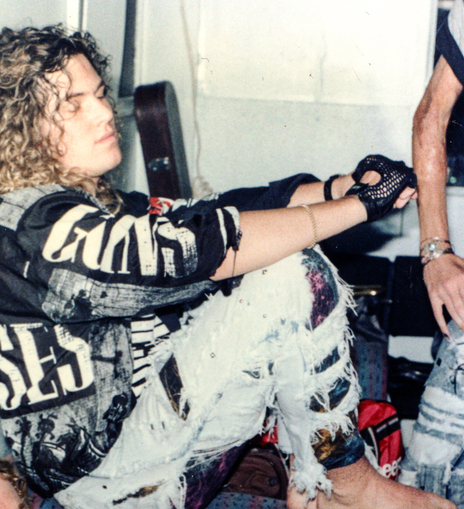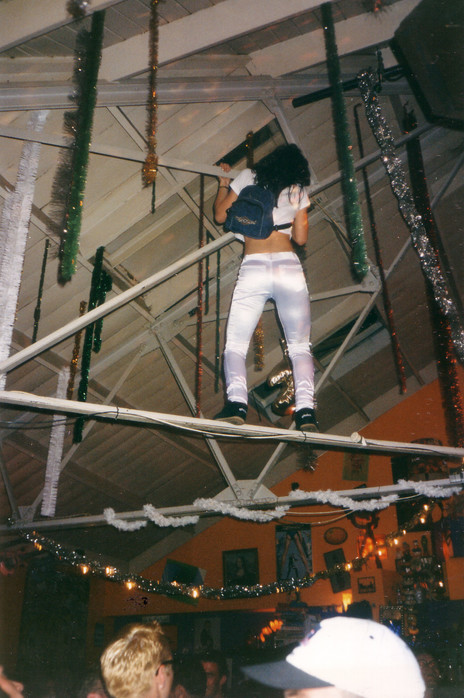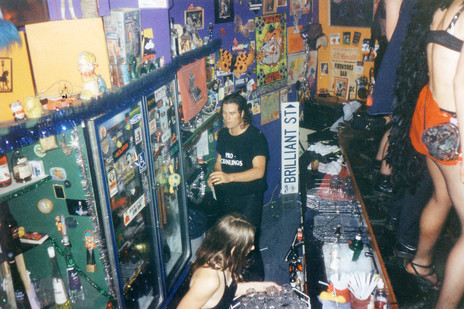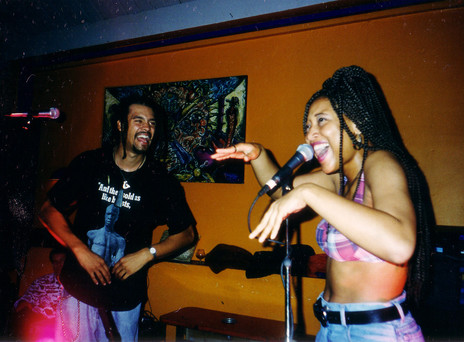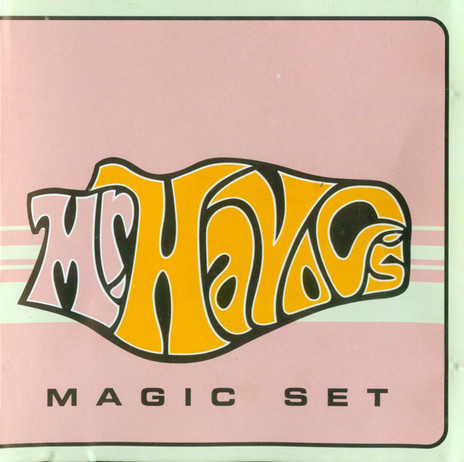Push Push
There were many early iterations of Push Push. Havoc’s cousin Ken first joined the band on Casiotone keyboard, before moving to the drums (and eventually leaving Westlake Boys to join Havoc at Rangitoto College). Another Rangitoto student, Andy Kane, had been having classical guitar lessons so transferred to electric for the band. The learning curve was steeper for Steve Abplanalp, after the others convinced him that his experience on trumpet would make it easy to pick up bass guitar for the fledgling group. Their influences ranged from US glam rockers Mötley Crüe to Kiss (they covered ‘Cold Gin’ at their first serious practice).
The story of Push Push’s rise to chart-toppers has been covered elsewhere on AudioCulture, but it’s still striking to reflect on the power of their youthful ambition. Before leaving school, they’d already managed to pack the nightclub Rage with 400 young fans (the owner sought special permission to have R16 shows) and did a month of Tuesday nights at another bar, Stanley’s.
In the last year of high school, they entered the music video contest held by television show Shazam! and hired out the school hall to film a lunchtime concert (the school made them pay for the privilege). Accompanied by a smoke machine and fireworks show they won with a live performance of an original song, ‘220 Volts’.
Graduating high school meant the band members had less free time (with Havoc taking a job as a record store clerk) and tensions emerged about the time they could devote to the band. Green no longer wanted to attend multiple practices every week and was dropped. A new drummer, Vincent Bashford, took part in their next television appearance – an interview on 3.45 Live! with host Rikki Morris about their upcoming support slot with Poison, which was followed by a homemade music video for their song ‘TV Blue’.
The line-up reached its final form with the addition of guitarist, Silver, and drummer Scott Cortese. Cortese was also a Rangitoto College alumnus and his former band, Whiskey and Lace, had played alongside Push Push as part of massively popular five-bands-for-five-dollars shows at the Powerstation, which got to the point that they were regularly drawing crowds of up to 900 people.
At the Power Station in the late 80s, gigs offering “five bands for five dollars”
often drew 900 people.
Their own tours pushed beyond to the main centres to the small towns in between. This hard work paid off – in 1990 they supported Skid Row at the Logan Campbell Centre and Alice Cooper at Mt Smart, then the following year their first official single, ‘Trippin’’, hit No.1.
Havoc recalls that ‘Trippin’’ was written just days after seeing The Ramones in 1989 and their song takes a similar straight-to-the-point approach (even the guitar solo is just whining harmonic scream). It was an instant rock classic and led to another big support – AC/DC at Mt Smart, Auckland. Yet, the band was also changing with the times – going from their make-up and glam days to wearing Jane’s Addiction, Nine Inch Nails, and Nirvana T-shirts in their music videos.
The album, A Trillion Shades of Happy, went to No.3 and spawned two further Top 10 singles – poppy rocker ‘What My Baby Likes’ and the anthemic ‘Song 27’. Havoc also appeared on ‘Money Worries’ by MC OJ and Rhythm Slave, which also nudged into the Top 40.
‘Trippin’’ hit No.25 in Australia and the band undertook a two-month tour, which included a month on the road with Australian star, Diesel. They performed on TV show, Hey Hey It’s Saturday, but the crew were hostile – they preferred acts to mime – and only gave them a short soundcheck. Their haphazard performance was seen as a wasted opportunity at the time, but their loose, grunge-y take on ‘Trippin’’ showed their energy, if not their chops.
The band were all set to relocate to Australia, when Havoc announced that he’d be staying behind.
“I really didn’t believe in the reasons that we were going to Australia. We’ve done that, we’re just going back to do it again. The Australian music industry was big enough that you’d find yourself doing things against your better judgement because everyone was saying, ‘you should do it, just this one time or just these three times.’ Plus, band practice had begun to feel like going to work. There were other reasons too that I don’t want to get into, but in the end my gut just said, ‘don’t go,’ so I stayed in New Zealand.”
Squid Bar
Near the end of his time in Push Push, Havoc began DJing at a downtown club, Attica, on Fanshawe Street. He began dating the manager, Vicki Cox, and helping to run the bar. When Attica came to an end, Cox and Havoc looked for another spot to open a club. Their first endeavour was a series of gigs under the name “Sunday School” at Punch and Judy’s Tavern on Fort Street – charging five dollars to see two bands play on Sunday afternoon. It later moved to Zog’s, at the old Wildlife location on Customs Street, under the name “The Church”.
The first iteration of Squid Bar opened on High Street in 1993 and Havoc found it was instantly popular, tapping into a burgeoning scene in the area which also had The Box/Cause Celebre and Bob’s Bar nearby.
“There was a real culture explosion in Auckland. It was becoming easier to hunt down interesting music. Before that, if it wasn’t in the music shop, you had to order an import and wait months for it to arrive, if it arrived at all … Auckland was moving beyond the era of bars having a dress code or places like Stanley’s having “girls drink for free” nights. The whole Generation X thing was happening. The music was becoming a bit smarter, more emotional and it was okay for a dude to hug another dude. People weren’t just going into town to start a fight.”
The first run of the bar only lasted six weeks because the leaseholder ran a restaurant upstairs and his debts became so bad that he “did a runner”. Cox and Havoc turned up to find both locations emptied out. Luckily, their sound equipment was left in a pile on the floor.
The pair were given an opportunity to restart Squid Bar when Andrew Mills (from legendary cafe DKD) offered to organise financing a new spot, with Shannon Cairns coming on board at a management level. They took over two floors of a building on O’Connell Street around the corner from the previous Squid, which meant bands could play on the first floor and a bar could run on the second.
Bono signed the toilet wall AT THE SQUID BAR, “but within an hour someone had cut it out with a Stanley knife!”
“While it was still being built,” says Havoc, “my friend Rick from PolyGram brought up U2 – they had a couple of vodkas and Bono signed the toilet wall, but within an hour someone had cut it out with a Stanley knife! ... The downstairs bar was finished first and we had the first Big Day Out [1994] after-party just after opening. Looking back, it was pretty bare and average. I remember hearing D’arcy from Smashing Pumpkins walking down the stairs, saying, ‘what a dump!’ – I was really offended. Later that night Chris Cornell [Soundgarden] told me to stop playing disco, which also broke my heart a little bit.”
During the mid-90s, Squid hosted a startling number of top local acts. Many of the top Flying Nun acts appeared: Headless Chickens, Garageland, The Tufnels, King Loser, The 3Ds, Cakekitchen. Dimmer played their first Auckland show at Squid and there were early appearances by rising stars Bic Runga, Tadpole, and Salmonella Dub. Supergroove previewed their album, Traction, by playing it in its entirety to select guests at one show.
Regulars from the Auckland hardcore scene also booked shows: Balance, Kitsch, DSM, and Dayone (along with their international kin: Sick of It All, All You Can Eat, etc). There were hip hop acts (DLT, Joint Force, Dark Tower), soulful singers (Grace), and hot young bands whose music may have faded, but whose names remain evocative of the era (Stayfree Carefree, Jungle Fungus, Shit Biscuit, Raw Meat From The Balcony).
An impressive run of internationals also performed at Squid, including: Cat Power, Dread Zeppelin, The 5.6.7.8’s, Alex Chilton, Jad Fair, Regurgitator, Gas Huffer, Kim Salmon, The Hellacopters, Shellac, Sprung Monkey, Ed Kuepper, and You Am I. There were also some more surprising performances squeezed into the corner of the upstairs bar – members of Suicidal Tendencies/Infectious Grooves stopped by to play a set of covers (often swapping instruments for fun) and Michael Franti (Spearhead) did an intimate performance.
Havoc’s musical tastes were broadening out and he found the crowd receptive to his playful DJ sets. “I could play the theme from Family Ties into James Brown into Danzig on a Friday night and everyone would be into it.”
Around the time Push Push was ending, Havoc had also begun DJing at 95bFM (doing the B By Candlelight slot on Wednesday nights). His glam rock background may have put him at odds with some station staff, but he soon overcame the majority of them with his enthusiasm and love of music. His on-air energy eventually saw him become the breakfast host in 1996.
Havoc’s on-air energy eventually saw him become the 95BFM breakfast host in 1996.
Havoc wasn’t involved with the 80s dance scene in Auckland, though Push Push did use ‘Theme from S’express’ as their intro music for live shows. Havoc got the cassette from an exchange-student girlfriend and then discovered acts like Bomb the Bass and Cookie Crew. He followed the scene from a distance through articles in Face and NME.
“I was fascinated. What was this thing Ecstasy? What was the bandana with the smiley face all about? Then when we started Squid, people from different walks of life kept asking, ‘do you play electronic dance music here?’ The thing that united them was they’d all come back from overseas and you could see they’d had a profound experience. I soon found the place would go off if I dropped a track like Josh Wink’s ‘Higher State of Consciousness’. Though it was ridiculous the amount of times I’ve blown the speakers in the middle of it and had to climb up to ‘MacGyver’ the fuses with a cigarette packet.”
Havoc’s growing knowledge of electronic music led to dance-orientated club nights including Island of E and the boundary-pushing Cheap Sex events that he put on with former bFM station manager Nick D’Angelo – which included burlesque performances and at one event, a live penis-piercing.
“The Cheap Sex parties were so mental. I’ve tried to explain some of what went on there to the younger staff at bFM and it sounds like I’m making up complete bullshit. It was so out there; it seems crazy that I was legally in charge of all that!”
New band, new DJ career
Havoc’s next band, Element, saw him team up with ex-Push Push drummer Vincent Bashford, though the band was a direct attempt to move in a different direction than their former outfit – sounding more alternative and atmospheric in places (with Havoc learning didgeridoo, so he could add to their leftfield sound). Element gained enough traction to play the smallest stage at Big Day Out but soon came to an end.
In 1996, Havoc joined a more motivated outfit, Fontanelle, which had been started by three former band members from Thorazine Shuffle – Antony McDonald (guitar), Chris Familton (bass), and Blair Miller (drums). The band’s sound was reminiscent of the more melodic second-wave grunge acts, like Stone Temple Pilots or Alice In Chains, providing a strong platform for Havoc’s big vocals.
Havoc’s growing confidence on didgeridoo led to a surprising offer: “Doug Hood’s Looney Tours did the first couple of Big Day Outs and he just rang me up one day to ask if I still played didgeridoo and if I wanted to play with Porno For Pyros? At that time, Perry Farrell was my biggest idol in the world, and I ended up onstage with them at the Big Day Out [1996] and at their Powerstation show. I still vividly recall setting up for the last song of their set and Perry saying to me, ‘okay Mike, you ready?’ I was so buzzed out it took me a moment to collect myself! ‘okay, now I am …’ It was cool as shit.”
Fontanelle began recording a debut EP at York Street Studio Two (in Shortland Street) in 1997, played the bFM Summer Series, and opened the main stage at the Big Day Out in 1998. However, Familton moved to Sydney in August and, although the band merely planned to take a hiatus, it ended up being permanent.
Fortunately, Havoc already had another serious musical outlet underway, with his interest in dance music leading him to become more serious about DJing.
In the late 90s Havoc’s interest in dance music led him to become more serious about being a DJ.
“I met Gideon, who was a top local DJ at the time, probably through Grant Fell. I don’t know why, but he was willing to let me go around to his place on Friday nights and learn to DJ properly. I so appreciate him letting me do that.”
By the late 1990s, Havoc was a respected house DJ and undertook huge slots: supporting Crystal Method in 1998, appearing at Splore in 2001, and playing with The Chemical Brothers on three separate occasions. He recalls them being “two of the most down-to-earth, genuine guys, not affected by their fame in any negative way at all.” In 2000, he joined Roger Perry on Red Bull’s “Summer Hummer” tour, which took them throughout small town New Zealand.
“I remember DJing on Hot Water Beach and putting on my favourite record, then running down and having a quick body surf before rushing back in time to put the next record on. It was ridiculous.”
Havoc and another bFM regular, Jason Rockpig, were prime instigators of the bFM-run dance party, Oonst. It sold out the Mandalay in its first year and by the time it was being held for the fourth time it was packing out two rooms of the St James Theatre complex. Havoc credits the support of local DJs – including Gideon, Chelsea, The Professor, and Luke da Spook – in helping him rise up through the local scene. His involvement with the dance party, Titanic, held on a boat in Waitemata Harbour, even led to a mix CD with Gideon – Titanic: The Captain's Cut.
Havoc is everywhere
Havoc had an impressively long run as breakfast host on bFM, initially taking the slot from 1996-2002. His manic on-air persona provided the perfect pep for a listener to get a start on their day and his eclectic music taste by this stage meant he could draw together fans of disparate forms of music – whether it be alternative rock, electronic music, or hip hop. Nor did he abandon his roots in heavy metal, always happy to throw some Kiss or Mötley Crüe into the mix if the urge took him.
Radio and bar work provided only a moderate income, so Havoc kept watch for other opportunities. One night at Squid, he got talking to Phil Smith and Nick Craig, who were both working on television show Sports Night. When they mentioned they needed a snowboard reporter, he (falsely) claimed he could snowboard and was given the job. He’d previously hosted the late-night music video show, Frenzy, though only his red-make-up-covered lips had appeared on-screen. He only began thinking seriously about doing a show when he found himself chatting with the film crew when the weather was too poor for snowboard reporting.
“We’d be sitting there in the motel room and I’d say, ‘if I could do a TV show, this is what I’d do.’ A lot of it was based on what the radio show had become. Gideon and Grant Fell helped me put a pitch together for a magazine-style show that I wanted to call Toast. We pitched it to Neil Roberts and it turned out he was a fan of the radio show, so he got it straight away. At our next meeting, he said, ‘it’s not going to be called Toast, it’s going to be called Havoc.’ Not long before that, I’d asked Jeremy [Wells] if he wanted to be involved and he said, ‘yeah, I suppose so.’ It was five nights a week live on MTV, so I was terrified when we started.”
Havoc jokingly referred to his MTV show as “one big drift net for the youth market”.
The first show of Havoc aired on MTV in 1997. It had a musical element right from the first episode – Darcy Clay was one of the in-studio guests; producer-director Paul Casserly was from bFM and a key member of Strawpeople. Havoc jokingly referred to the show as “one big drift net for the youth market”, given its edgy humour and finger-on-the-pulse culture reporting. It boosted local music whenever it could, showing local videos and having musicians on as guests. It lasted less than a year and had a final show with live performances by Shihad, Jan Hellriegel, and Thorazine Shuffle.
Fortunately, it was picked up by TVNZ and moved to a late night, one-hour slot which allowed the pair to keep their irreverent humour and also gave them room for weekly musical guests including Mary, Voom, and The Peter Stuyvesant Hitlist. It took on slightly different names over the years (eg Havoc 2000) though always relied on Havoc’s mile-a-minute energy and Jeremy Wells’ more wry, faux-serious delivery.
The show took the same playful approach to music slots – at one point setting up two-piece band, The Hasselhoff Experiment, on the back of a flatbed truck and driving them around the streets of Orewa. The retirees were more bemused than shocked, while singer/guitarist, Andrew Tolley, recalls it being more nerve-wracking on the crew.
“We took a roundabout at the hellbent-for-leather speed of 15kms and one vocal PA speaker bounced destructively off the truck and onto the tarmac, and two musos, one cameraman and a soundie collided domino styles into each other. Noise control, a police officer and an afternoon of literal destructo punk roknrol came to its inevitable ending!”
Havoc was so busy around this time that when the show filmed a special at Big Day Out 1999, he also DJ’d in the Boiler Room that same day. Not surprisingly, his attention moved away from Squid Bar over this time and Vicki Cox had moved away a couple of years earlier, so it wasn’t able to survive into the new millennium.
One of the most memorable series that the pair did together was Havoc and Newsboy’s Sell-out Tour, though Havoc remembers it was originally planned for another pair of hosts, with the intention that it would be a lighthearted examination of small-town life. It soon became clear that this version made for boring viewing so the funding was redirected towards a more edgy show fronted by Havoc and Newsboy. Their sense of humour sometimes rubbed locals up the wrong way, particularly when they announced Gore as the “gay capital of New Zealand” (a statement the Mayor refuted harshly in the media soon after).
Havoc finally parted ways with Wells after one final series together – Havoc Luxury Suites and Conference Facility – and the pair left a legacy of groundbreaking, if sometimes controversial television. Among the stunts was one in which they used the news reporter’s van for a fake story about Wells visiting a prostitute. In another, they broke into a factory chicken farm.
In 2004, Havoc moved to TV3 and took the central role by himself on Havoc Presents Quality Time. It ended up being the last of Havoc’s own shows, though he remained a television regular with presenter roles that spread from Top Town to Treasure Island – to date, he has filmed over 300 episodes of various television shows.
Old is new
Havoc returned to bFM as breakfast host in 2006 and stayed until 2010 before heading to Radio Hauraki, though this was short-lived. In a surprise move, bFM manager Hugh Sundae again brought him back as breakfast host from 2017-2019, with the hope that his experience and passion would rub off on the younger staff. Given the youthful nature of the station, the role was always going to be short-term, so it was no surprise when Havoc moved on to become an occasional guest on TV3 news and lifestyle show, The Project.
He also continued to perform irregularly as a DJ, for example playing the two-year anniversary for popular before-work dance rave “Morning people” in 2018.
Push Push has also proved to have some surprising longevity, after they decided to re-form for a few shows.
Push Push
re-forms:
“Within five minutes, it felt like we were all 18 again.”
“At one stage, we hadn’t been in the same room together for 20 years. We grew apart, did our own thing. Then it turned out we were all going to be in Auckland at the same time and somebody suggested we should hire a practice room and have a jam. I’d been in touch with Steven and Scott quite a bit, but not so much the others – especially Shane and Andy who live in Australia ... Within five minutes, it felt like we were all 18 again. Some songs we played all the time we couldn’t remember, while there’d be others where someone would play a riff and I’d go ‘oh my god, we did write a song like that’ and all the words would erupt out of my mouth.”
After playing a small show at Burger Fuel HQ in Grey Lynn, the band were offered a support with The Darkness for a three-date tour through New Zealand. Havoc takes great joy in the fact that for three decades, his endeavours have provided a backdrop to some of people’s most enduring memories.
“Increasingly over the years, I’ve had people come up to me and say, ‘fuck you changed my life.’ They’ll be quite specific about it too – whether it was down in Hamilton and they broke into a Push Push show through the back window or they had their first pash at our gig … There’s a common thread to what I did in the band or at Squid or on radio and television. For many people – more than I genuinely would’ve thought – it marked a specific time in their lives that they loved, so it’s awesome to think I was part of all that.”
--
Bands that played at Squid
Locals:
Able Tasmans, All Torn Up, Wayne Anderson, Apollo Deluxe, Bad form, Balance, Bike, Breathe, Cabbage Bomber, The Chills, China Man-chu, The Clean, Cake Kitchen, Crash, Dam Natives/Native Bass, Dark Tower, Datura, Dayone, Dead Flowers, Dimmer, Disjecta Membra, DLT, D.O.M.E., DSM, Evilis, Fagan, Figure 60, Flesh D-Vice, Funhouse, Future Stupid, Garageland, Grace, Hallelujah Picassos, The Hatebreeders, Headless Chickens, HDU, Jan Hellriegel, HLAH, Peter Jefferies, Jungle Fungus, Joint Force, David Kilgour, Killer Ray, King Loser, Kitsch, Chris Knox, The Mad Scene, The Managers, Mecca Normal, Mighty Asterix, Mink, Muckhole, The Nerve, The Nixons, Nothing At All, Nudie Suits, Pash, Pet Rocks, Propeller, Psycho Dazies, Pumpkinhead, The Rainy Days, Teremoana Rapley, Raw Meat for the Balcony, Bic Runga, Shit Biscuit, Sniff, Sol-e, Solex 500, Saturn 5, Marty Sauce and the Source, Skunkhour, The Snitches, Spacesuit, Squirm, The Tufnels, New Loungehead, Reserved For Emily, Salmonella Dub, Shaft, Smoothy, Shirley, Bob, & Aaron, Seven Dials, State of Grace, Stay Free Carefree, Sticky Filth, Suka, Superette, Supergroove (pre-release show for the Traction album), Swarm, Thorazine Shuffle, 3Ds, Tim Teen and the Teen Tones, The Trains, Treehut, Solid Gold Hell, Who Killed Marilyn, Warners, Weta, Voom.
Internationals:
All You Can Eat, Cat Power, Alex Chilton, Dread Zeppelin, 5.6.7.8's, Jad Fair, Michael Franti, Gas Huffer, The Hellacopters, Ed Kuepper, Regurgitator, Kim Salmon, Shellac, Sick of It All, Sprung Monkey, Suicidal Tendencies, Vision of Disorder, You Am I.
